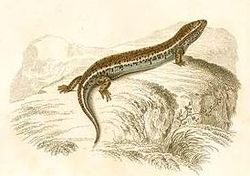| Chalcides | |
|---|---|
 | |
| Chalcides ocellatus | |
| Scientific classification | |
| Domain: | Eukaryota |
| Kingdom: | Animalia |
| Phylum: | Chordata |
| Class: | Reptilia |
| Order: | Squamata |
| Family: | Scincidae |
| Subfamily: | Scincinae |
| Genus: | Chalcides Laurenti, 1768 |
| Species | |
About 30, see text. | |
Chalcides is a genus of skinks (family Scincidae).
It is usually placed in the subfamily Scincinae (= Scincidae sensu Hedges 2014), a monophyletic clade of primarily African skinks.